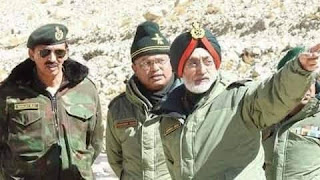In the deadliest clash with the Chinese in decades, 20 Indian soldiers, including a Commanding Officer, were martyred in the Galwan Valley on Monday, June 15.
This violent face-off came at a time when both South Asian neighbors were engaged in "de-escalation" in the high-altitude area.
So, how did the disengagement process turn into a bloody episode? Let's take you through the series of events.
The People's Liberation Army and Indian troops have been locked in an eye-to-eye situation since May in several key areas, including Pangong Tso and Galwan Valley.
Irked by India's rapid infrastructure push in strategic locations of the Line of Actual Control (LAC), China sent hundreds of soldiers to support its frontline PLA members.
India too deployed units and clarified infrastructure projects won't be stopped.
Clashes
It all started with a clash on May 5-6
The first skirmish happened on May 5-6, when Indian and Chinese patrols on the northern bank of Ladakh's Pangong Tso lake clashed. The confrontation involved 250 men, stones were used, and both sides suffered injuries.
In the following days, several such incidents were reported from north Sikkim's Naku La and Galwan Valley.
China accused India of trespassing and Delhi said Beijing hindered normal patrols.
Visits
Army Chief visited the area, Rajnath Singh said talks underway
Amid brewing tensions, Indian Army Chief General MM Naravane visited Leh-based 14 Corps headquarters on May 22. Meanwhile, China marshaled nearly 5,000 soldiers and India too sent military reinforcements.
Subsequently, Defense Minister Rajnath Singh admitted to tensions, assuring that talks are underway at military and diplomatic levels.
Though dialogue was preferred, the government won't let India's dignity suffer, he said.
Talks
On June 6, senior officers talked, disengagement followed
As a part of de-escalation through talks, Lieutenant General Harinder Singh, Commander of 14 Corps and Major General Lin Liu, Corps Commander, South Xinjiang Military Division, sat for a conversation on June 6.
Later, it was reported that the Chinese withdrew troops from Galwan Valley, PP-15, and Hot Springs in Eastern Ladakh by 2-2.5 kilometers.
But mid-week, PLA returned and set up a camp.
What happened
Indian troops were waiting for Chinese to respect agreement
The camp was dismantled, prompting a scuffle, in which both sides suffered injuries. On Sunday, June 14, the Chinese returned with more soldiers leading to another clash.
On Monday evening, the 16 Bihar regiment was waiting for the Chinese to uphold the agreement and return to Post 1, about 5 kilometer to the east.
The Chinese, however, attacked the patrol team.
Attack
Using rocks wrapped with wire, Chinese attacked Indian soldiers
The Chinese aggravated the situation by attacking Indian soldiers with boulders. They also wrapped rocks with barbed wire and nailed wooden logs and used them for the clash.
Colonel Santosh Babu was injured in the attack. The Indian side took him and another injured havaldar away from the spot, leaving some soldiers, who were reportedly held captive by the Chinese.
No shots were fired.
Casualties
China reportedly lost 43 soldiers after Indian troops attacked
Nearly 40 minutes after the first clash, the same unit returned to ground zero, this time led by a Major, and things escalated further.
Indian troops retaliated strongly, injuring some 55-56 Chinese soldiers. The number couldn't be confirmed but ANI said China lost 43 soldiers.
The clash continued for hours. All this happened near a ridge and some soldiers fell into the Galwan river.


Comments
Post a Comment